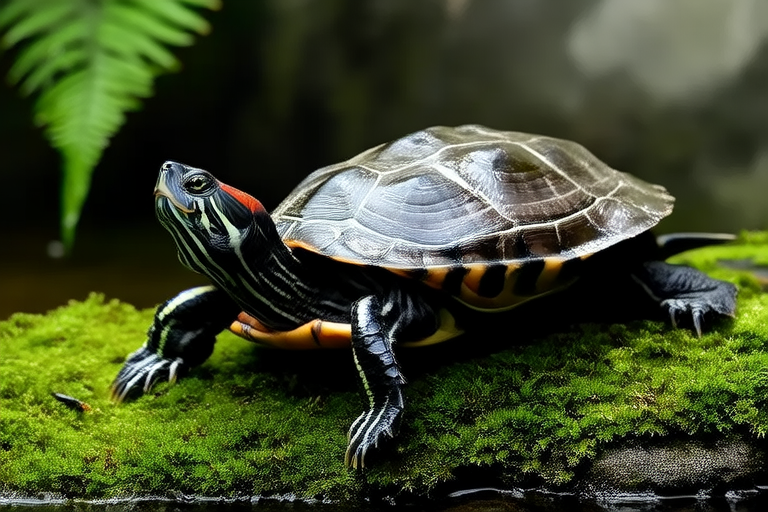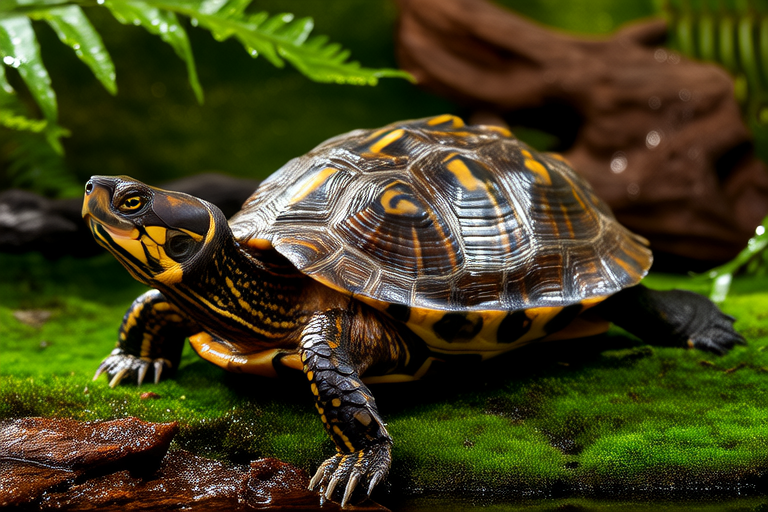
Three-Striped Box Turtle: A Beginner’s Guide to Perfect Pet Care
Welcome to your ultimate guide on caring for the Three-Striped Box Turtle! As a popular choice among reptile enthusiasts, this turtle species is known for its unique appearance and relatively easy care requirements. This article will walk you through everything you need to know about housing, diet, health care, and handling your new pet. By following these guidelines, you’ll be well-equipped to provide the best possible life for your Three-Striped Box Turtle.
Introduction to the Three-Striped Box Turtle
The Three-Striped Box Turtle (cuora trifasciata) is native to China, where it thrives in humid forests and grasslands. It gets its name from the three distinctive yellow stripes that run down its dark brown or black shell. These turtles are generally docile and can live up to 30 years with proper care. Their small size makes them ideal pets for those who want to enjoy the companionship of a reptile without the need for large enclosures.
Habitat Setup Requirements
Enclosure Size
When setting up a habitat for your Three-Striped Box Turtle, the first thing to consider is the size of the enclosure. Adult turtles require at least 4 square feet of floor space per turtle. Juveniles can start in smaller enclosures but should be moved to larger ones as they grow. A long, low aquarium or a custom-built enclosure works well. Ensure there is enough room for your turtle to move around comfortably.
Substrate
Selecting the right substrate is crucial for maintaining a healthy environment. Cypress mulch, coconut fiber, or reptile-safe bark chips are excellent choices. Avoid using gravel or sand, as these can cause impaction if ingested. The substrate should be kept clean and dry, with regular spot cleaning and complete substrate changes every few months.
Temperature and Humidity
Maintaining appropriate temperatures and humidity levels is vital for your turtle’s health. Daytime temperatures should range between 75°F and 85°F (24°C to 29°C), while nighttime temperatures can drop slightly to around 70°F (21°C). Use a combination of under-tank heating pads and overhead heat lamps to achieve these temperatures. Additionally, ensure that the humidity level stays between 60% and 80%. Mist the enclosure daily or use a humidifier to maintain the correct moisture levels.
Lighting
Your turtle needs both UVB and UVA light for optimal health. UVB light helps with calcium absorption and prevents metabolic bone disease, while UVA light promotes natural behaviors like basking and foraging. Provide a 10%-12% UVB lamp and a full-spectrum fluorescent bulb that emits UVA rays. Place the lights so that they cover one-third of the enclosure, allowing your turtle to bask under the light and retreat to cooler areas when needed. Remember to replace the bulbs every six months, even if they still appear to be working, to ensure they are providing adequate UV output.
Diet Specifics
What They Eat
The Three-Striped Box Turtle is omnivorous, meaning it eats both plant matter and animal protein. In the wild, their diet consists of insects, snails, worms, and various fruits and vegetables. As a pet owner, you can replicate this diet by offering a variety of fresh produce such as leafy greens (kale, collard greens, dandelion greens), shredded carrots, and apples. For protein sources, consider mealworms, crickets, and earthworms. Commercially available turtle pellets can also be included in their diet as a supplementary food source.
Feeding Frequency
Feed your turtle every other day, ensuring that each meal is balanced and nutritious. Juvenile turtles should be fed more frequently than adults, as they require more energy for growth. Monitor your turtle’s weight and body condition to adjust the feeding schedule as necessary. Always provide fresh water in a shallow dish for drinking and soaking. Change the water daily to prevent bacterial growth.
Health Care Tips
Signs of Illness
It’s essential to monitor your turtle’s behavior and physical condition regularly. Some signs of illness include lethargy, loss of appetite, swollen eyes, discharge from the nose or mouth, and difficulty moving. If you notice any of these symptoms, consult a veterinarian specializing in reptiles immediately. Early intervention can often prevent more serious health issues.
Common Diseases
Metabolic Bone Disease (MBD) is a common ailment in box turtles due to improper calcium absorption. Symptoms include soft shells, weak limbs, and abnormal posture. To prevent MBD, ensure that your turtle has access to adequate UVB lighting and a calcium-rich diet. Respiratory infections can also occur if the enclosure is too cold or damp. Keeping the environment warm and dry can help prevent these infections.
Preventive Measures
To keep your turtle healthy, follow a regular cleaning schedule for the enclosure and maintain proper hygiene practices. Quarantine any new additions to your collection for at least 30 days before introducing them to your existing pets. Regular veterinary check-ups are recommended, especially for young turtles or those showing signs of illness. Vaccinations may be necessary depending on your location and the specific risks in your area.
Handling Advice
While Three-Striped Box Turtles are generally docile, they should be handled gently and infrequently. Over-handling can stress your turtle, leading to health problems. When picking up your turtle, support its body with both hands, being careful not to squeeze or drop it. Always wash your hands before and after handling your pet to avoid transferring harmful bacteria or chemicals.
By following the guidelines outlined in this article, you’ll be able to provide a safe and comfortable home for your Three-Striped Box Turtle. Remember that every turtle is unique, so pay attention to your pet’s individual needs and adjust care accordingly. With patience and dedication, you and your turtle will enjoy many happy years together.





